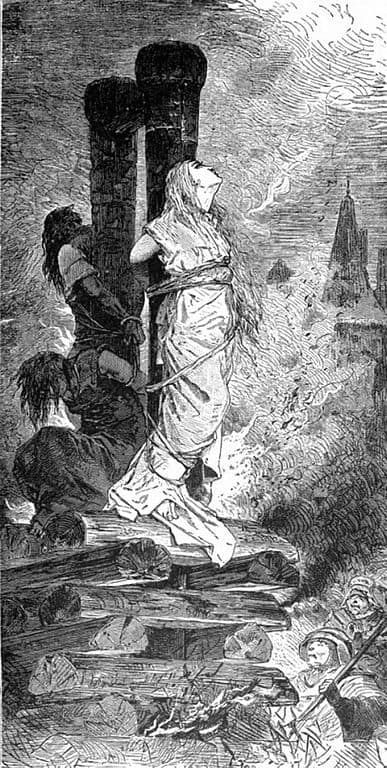According to many historians, the European witch trials were far larger and more aggressive than those in Salem. For some reason, the trials in Salem get all the fame, but I encourage every witch to learn about the European witch hunts in order to get the full picture of how the world treated witches.
In the late 16th century, people all across Europe were accused of witchcraft and executed. This is a dark part of history that many know little about.
What caused this to happen? Why did some people get convicted while others managed to escape without harm?
The answers lies in the social structure of the time period, which was heavily influenced by religion.
Witchcraft Before The European Witch Hunts
Before the 1400s, Europeans generally believed in magic. However, what that looked like varied dramatically by place.
Sicilians told tales about groups of seductive women with animal hands and feet; Norwegians recounted their world inhabited by earth trolls while no pan-European agreement existed on who witches were or even if they should be feared at all.
Many people practiced “magic” in some form, whether they concocted folk spells or healed the townspeople with herbs. The Catholic Church saw virtually no threat to this for the previous thousands of years and witches were not persecuted.
It wasn’t until the late 1400’s that the idea of the witch on a broom, kidnapping children in the night and casting curses on townspeople, was invented.
With the rise of Christianity, theologians began publishing demonology handbooks and guides to exterminating witches that solidified what it is a witch does.
Thus, the classic picture of the witch was born, which essentially kicked off the witch trials in England and in Europe, and later in America.
The idea that witches convened with the Devil was really at the heart of the issue. After all, in a world that was mostly Christian, the idea of someone worshipping the Devil was one of the most evil ideas.
What Are The European Witch Trials?
The European witch trials were also known as the Great Witch Hunt, and began with a series of priest-led purges.
The European witch hunts mainly took place in Europe during the early 1600s. The witch hunts resulted in a wide variety of executions, ranging from “hanging, burning at the stake, boiling in oil or water,” and being “stoned to death.”
The hunts escalated into something much more violent after 1609; by that time people suspected of witchcraft could be executed for even mentioning their power or using any magic whatsoever.
The beginning of the European witch hunts was quite small.
In the small settlement of St. Maximin in 1572, authorities charged a woman named Eva with using witchcraft and murdering children. She confessed under torture, but she was only one victim; two women that were implicated by her confession also met their fate when they burned at stake along with Eva for killing innocent humans.
Five years later, over 500 people had been killed in the town alone, although the population count was only about 2,000 people!
The heart of witch-hunting in Europe was the German speaking region, a place that includes modern day Germany, Switzerland and northeastern France.
Unfortunately, the European witch hunts lasted for hundreds of years, until 1782.
Why Did The European Witch Hunts Begin?
The Witch Hunts in Europe began for a number of reasons.
Some historians believe the hunts were spurred on by an unusually cold winter that led to crop destruction, causing famine and disease outbreaks as well. Others have pointed to social upheaval following political changes like the Protestant Reformation or wars such as The Thirty Years War (which lasted from 1618-1648) as a cause for the hunts.
However, many scholars now believe that the European Witch Hunts began because of social unrest stemming from rapid cultural changes and greater inequality between rich and poor people in Europe during this time period.
With the rise of Martin Luther, Catholicism’s power was challenged and many people began to convert. With a new strategy in place that would seemingly work against their monopoly on religion, the Church struggled greatly with how to approach this revolution and what strategies were most effective for them.
They chose two main tactics: inquisitions where heretics who persisted in heresy could be punished by death or forced conversion; crusades which allowed those who voluntarily converted back into Christianity not only forgiveness but remission from all sins committed before baptism as well as immunity from any future prosecution under church law.
However, monarchs, especially in Germany, began to move away from the Catholic Church. This is probably why Germany was a hub for the European witch trials.
For centuries, it was common for townsfolk to believe in witchcraft. They would buy and sell magical services like love potions and spells as a way of helping find stolen belongings or maybe even someone’s true love.
Up until the 1500’s, the Catholic Church had been mostly indifferent about witches. However, Protestants did not have the same thoughts about witchcraft. Both Luther and Calvin, famous religious figures, encouraged witch hunts and witch trials in Europe and England.
Many scholars believe that religion ultimately sparked the witch trials in England and Europe due to the increased religious competition.
However, other scholars believe that the culprit was social inequality.
For example, many women were widowed or became single mothers following wars, so they turned to begging out on the streets and took on the profession of a healer to make money.
During this time period women were expected to be pious housewives that stayed at home taking care of their children instead of working outside the home. So when these widows turned to begging or becoming healers they faced criticism from both men and women in society who considered these women to be immoral, and as a result they were accused of witchcraft.
This “attack” on the traditional view of what it meant to be a woman in society led to accusations against these widows for being witches by people who feared they would lose their place in the hierarchy if gender roles began changing. This lead many scholars to believe that the European Witch Hunts were not simply a religious movement but also an effort to maintain class and gender hierarchies in society.
Many historians now argue that this social unrest led to accusations of witchcraft against these women for two reasons: they had become independent and taken on professions traditionally believed to be only male occupations; and they were challenging the gender roles of what it meant to be a woman in society.
So basically, religion played a part in the execution of the European witch trials, but it wasn’t necessarily the cause. It’s impossible to say how much religion contributed to this gender equality, however it was ultimately the social climate that caused the witch trials in Europe to begin in the first place.
How Many People Died In The European Witch Hunts?
It is estimated that between 40,000 and 100,000 people were executed for witchcraft during this time, making them far more gruesome than the Salem Witch Trials.
However, certain places in Europe had a higher concentration of executions than others.
In the year 1684, there were over 700 witches executed in Württemberg and Bavaria alone. Specific towns would have higher rates of witchcraft executions than others, and these townships tended to be in the Christian regions that were more likely to adhere to church laws.
One such example was Trier, a town located on the border between Germany and Luxembourg with an execution rate peaking at over 200 people per year!
How The Public Reacted To The Witch Trials In Europe:
To the common person in the 1500’s, the idea of witchcraft was terrifying. There were many superstitions and beliefs that people had about witches, including but not limited to the idea of “flying ointments” which was an oil made from a combination of various plants such as hemlock or mandrake, containing powerful hallucinogens like belladonna or ergot fungus.
Another superstition about witches was that they could create hailstorms during harvest time to destroy farms- this is because hail is made from ice droplets which fall upon plants in order to choke them out with frost.
Of course, these wild ideas made the European witch hunts all the more frightening to the common people, who didn’t have means of research that we have today, like the internet. They quite literally had to take the word of their superiors as the truth.
The people who were accused of witchcraft in Europe during the 16th century could be any woman, man or child. The truth was that a witch hunt often starts with an accusation from someone out of anger, jealousy or vengeance- not because there had been any evidence for their guilt.
Usually this would lead to these accusations being brushed off and ignored, but if the accusation had been made by an influential person in the town then it could have led to a witch hunt.
If accused of witchcraft, one’s property would be seized and they would be tortured until they confessed or died- often resulting in unjust sentences for those who were innocent.
One famous example that demonstrates this is when two women were found guilty of witchcraft and burned alive in the small town of Wiesensteig, Germany.
This was just one example that demonstrates the belief system during this time period. Another famous case is when a female healer named Anne Green (also known as Mother Ann Lee) was convicted for being a witch after she preached to her followers about equality.
Basically, many people actually believed in witches and were quite terrified of them, but there was also a large portion of the population who used the European witch trials to their advantage in order to cease money/property or to get revenge.
Still others didn’t believe in witches, but simply tried to stay out of the limelight in order to survive.
What Types Of Things Were Witches Accused For?
During the European witch hunts, someone could be accused for many reasons, including:
-Having a physical attraction to the opposite sex
-Not performing household chores or duties such as cooking, cleaning and caring for children appropriately.
-Cursing someone by sticking pins in an effigy of them
-Being jealous of another person’s success or good fortune. –
-Slapping someone in the face
-Giving another person bad looks or gestures
-Speaking badly about another person when they are not within earshot
-Having an interaction with someone and then they later fall ill
-Having an odd birthmark or mole on your body
-Using herbs or natural remedies to heal someone rather than exorcisms
Of course, you were more likely to be accused if any of these actions were directed at someone influential. Generally, the more influence your accuser had, the more likely you were to be convicted.
The Legacy Of The European Witch Trials Today:
The European witch trials have had a lasting impact on the world.
The European witch trials were officially over by 1750, but this legacy has survived in popular culture for centuries afterward.
For example, many people still believe that witches exist and are living among us today, even if they don’t actually practice. The idea of the witch who flies through the night on her broomstick is still frightening to many.
In addition, many children’s fairy tales and folktales are based on the European Witch Trials.
We are actually surrounded by the superstitions of the European witch hunts, whether we know it or not.
Luckily, many societies offer freedom of religion today, so witches are able to practice and coexist alongside Christians as well as followers of other religions.
In conclusion, the European witch hunts were a dark period in Europe when people would be persecuted for being witches.
These days we don’t take these sorts of accusations seriously and most likely will not see another “witch trial” again. The only thing that is left of this time are old stories about it and some movies or TV shows with references to them.


